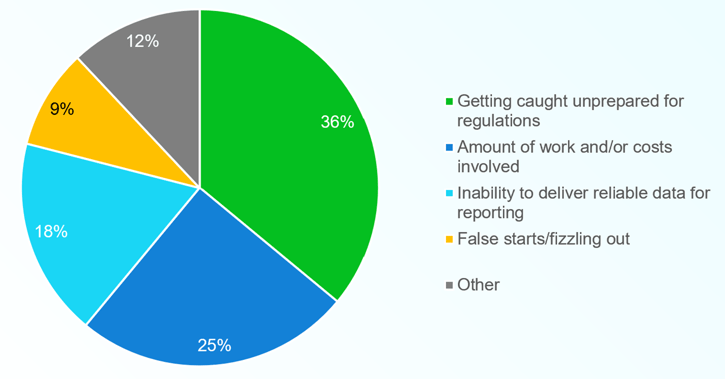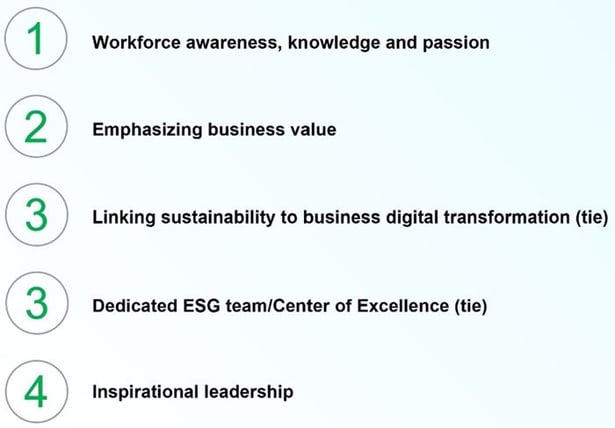It’s difficult to document best practices and critical success factors for IT-led sustainability transformation. Most CIOs and CTOs don’t even have sustainability on their agendas, let alone a track record to study.
Luckily, we had the opportunity in early May to poll multiple winners of the SustainableIT Impact Awards, honored for their progress in environmental, social, and governance sustainability (ESG). The poll of 25 companies also included executive board members of SustainableIT.org, all of whom have made a commitment to lead sustainable transformation in their IT organizations, enterprises, and industries.
What exactly is IT sustainability, anyway? SustainableIT.org defines it as the strategic leadership of enterprise technology to minimize negative and maximize positive impacts on the environment and society.
What’s not included in that definition is the essential goal of compliance with existing and coming ESG regulations. Compliance is, in fact, the most urgent motivator for sustainability action across the enterprise. When asked to name their greatest current anxieties about their contribution to sustainability, 38 percent of respondents cited “getting caught unprepared for regulations.” This was the most commonly chosen concern.
Figure 1: Leaders’ Greatest Current Anxieties Regarding IT’s Sustainability Contribution

Source: SustainableIT Board Poll, 2023
Progress and Priorities
IT organizations have made the most sustainability progress in energy consumption and emissions reductions, followed by IT workforce diversity and inclusion, and e–waste reduction (respondents were asked to indicate the top three areas of progress to date). The least progress has been made in creating a culture of sustainability and building sustainability into day-to-day decision-making. This is understandable, since cultivating a new culture can take years. Making sustainability a natural part of the IT development lifecycle also takes time and is dependent on sustainable thinking becoming a cultural norm.
Figure 2: Top Areas of IT ESG Progress and Top Priorities for Next 12 Months

Source: SustainableIT Board Poll, 2023
The top priorities for the coming year do not entirely reflect the areas of most progress. Reducing energy consumption and emissions is the highest selected priority, and is aligned with predominant corporate focus on this goal. But respondents recognize that their technology supply chain – specifically their hardware, software, and cloud-hosting vendors – generates the majority of their emissions footprint in the form of Scope 3 emissions. For that reason, sustainable sourcing initiatives are respondents’ second-highest priority in the coming 12 months.
Keys to Success
The most impactful critical success factors (CSFs) for IT’s ESG progress has been workforce awareness, knowledge and passion. When IT staff and stakeholders are enthusiastic, or at least accepting of, the part they must play in achieving business sustainability, change management becomes easier, as does the ability to channel time and resources to ESG initiatives. When asked their top goal for joining the SustainableIT community, most IT leaders cite improving team knowledge and awareness. Moving hearts and minds – and wallets – can only happen with a thorough knowledge of IT's environmental footprint and the potential for improvement. To illustrate that impact, in the financial services industries, for example, IT alone contributes 45 percent of the industry’s Scope 2 emissions.
To help IT leaders demonstrate the broad spectrum of impact that IT can have on ESG, SustainableIT.org has documented and shared more than 200 ESG topics and metrics of particular relevance to IT as well as sustainability impact models and levers for IT functions in any industry.
Figure 3: Critical Success Factors Ranked by Impact

Source: SustainableIT Board Poll, 2023
Demonstrating the cost benefit of sustainable operations was the second-most potent CSF. There are obvious parallels here to digital transformation, which likewise involved fundamental change and upfront investments that ultimately paid off in efficiency and agility. Demonstrations of cost benefit went a long way toward reducing friction and winning over reluctant C-suites and finance teams.
When it comes to winning sustainable IT supporters and turning doubters into believers, poll results point to one contribution that goes even farther than demonstrating business benefits: Delivering a comprehensive enterprise sustainability transformation strategic plan. That is a daunting task, but IT has done it before with digital business transformation and cyber risk management, to name two examples. Proactive IT leaders among the polling group are forming strategy teams and building these plans with willing business peers and dedicated sustainability officers, where present.
The results from this poll of relatively advanced and committed IT leaders shows that the success factors and ongoing challenges of IT-led sustainability transformation are quite similar to digital transformation and cyber risk management. Those efforts had their leaders and laggards as well. But it is comforting to know that for the most part IT has been there and done that, and will be able to do so again.
|
Related article: By Niklas Sundberg |

Written by Richard Pastore
Richard Pastore is Research Principal at SustainableIT.org, a nonprofit organization led by technology executives whose mission is to advance sustainability around the world. Previously, Pastore was Senior Director, Technology Research Advisor for The Hackett Group, a strategic consulting and research firm. He is former editor of CIO magazine, and vice president of the CIO Executive Council.



